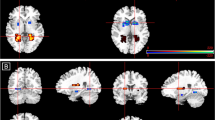Abstract
Background
Emotional processing measures are sensitive to acute administration of clinically useful antidepressant drugs. We wished to test the hypothesis that these models would also be able to detect agents likely to cause depression as an adverse effect. The anti-obesity drug and cannabinoid type 1 receptor antagonist, rimonabant, is associated with significant rates of depression and anxiety in clinical use.
Materials and methods
Thirty healthy adult volunteers were randomly assigned to receive a single dose of rimonabant (20 mg) or lactose placebo in a double-blind, between-groups design. Three hours after medication administration, subjects undertook an emotional processing test battery including facial emotion recognition, emotional word attentional dot probe, self-relevant word classification, emotional and declarative memory and the emotion-potentiated acoustic startle response. Subjective state was assessed via self-report measures.
Results
A single dose of rimonabant did not alter subjective mood. However, rimonabant selectively reduced incidental recall of positive self-relevant adjectives, an effect contrary to that seen following the administration of antidepressants. There were no effects of rimonabant on the other measures of emotional processing.
Conclusions
These results suggest that a single dose of rimonabant decreases positive emotional memory in the absence of changes in subjective state. Further studies are required to examine whether rimonabant might produce a wider range of negative emotional biases with repeated treatment.


Similar content being viewed by others

References
Anderson NH (1968) Likableness ratings of 555 personality-trait words. J Pers Soc Psychol 9:272–279
Bouhuys AL, Geerts E, Gordijn MC (1999) Depressed patients' perceptions of facial emotions in depressed and remitted states are associated with relapse: a longitudinal study. J Nerv Ment Dis 187:595–602
Bradley BP, Mogg K, Williams R (1995) Implicit and explicit memory for emotion-congruent information in clinical depression and anxiety. Behav Res Ther 33:755–770
Christensen R, Kristensen PK, Bartels EM, Bliddal H, Astrup A (2007) Efficacy and safety of the weight-loss drug rimonabant: a meta-analysis of randomised trials. Lancet 370:1706–1713
Davis M, Falls WA, Campeau S, Kim M (1993) Fear-potentiated startle: a neural and pharmacological analysis. Behav Brain Res 58:175–198
Ekman P, Friesen WV (1976) Pictures of facial affect. Consulting Psychologists Press Palo Alto, CA
EMEA (2008) PRESS RELEASE: The European Medicines Agency recommends suspension of the marketing authorisation of Acomplia. http://www.emea.europa.eu/humandocs/PDFs/EPAR/acomplia/53777708en.pdf European Medicines Agency Press Office
Griebel G, Stemmelin J, Scatton B (2005) Effects of the cannabinoid CB1 receptor antagonist rimonabant in models of emotional reactivity in rodents. Biol Psychiatry 57:261–267
Gur RC, Erwin RJ, Gur RE, Zwil AS, Heimberg C, Kraemer HC (1992) Facial emotion discrimination: II. Behavioral findings in depression. Psychiatry Res 42:241–251
Harmer CJ, Hill SA, Taylor MJ, Cowen PJ, Goodwin GM (2003) Toward a neuropsychological theory of antidepressant drug action: increase in positive emotional bias after potentiation of norepinephrine activity. Am J Psychiatry 160:990–992
Harmer CJ, Mackay CE, Reid CB, Cowen PJ, Goodwin GM (2006) Antidepressant drug treatment modifies the neural processing of nonconscious threat cues. Biol Psychiatry 59:816–820
Harmer CJ, Heinzen J, O'Sullivan U, Ayres RA, Cowen PJ (2008) Dissociable effects of acute antidepressant drug administration on subjective and emotional processing measures in healthy volunteers. Psychopharmacology (Berl) 199:495–502
Larson CL, Ruffalo D, Nietert JY, Davidson RJ (2000) Temporal stability of the emotion-modulated startle response. Psychophysiology 37:92–101
Lichtman AH (2000) SR 141716A enhances spatial memory as assessed in a radial-arm maze task in rats. Eur J Pharmacol 404:175–179
Pertwee RG (2005) Inverse agonism and neutral antagonism at cannabinoid CB1 receptors. Life Sci 76:1307–1324
Rey A (1964) L’examen de clinique en psychologie. Paris, Presses Universitaires de France
Segal ZV, Kennedy S, Gemar M, Hood K, Pedersen R, Buis T (2006) Cognitive reactivity to sad mood provocation and the prediction of depressive relapse. Arch Gen Psychiatry 63:749–755
Shiflett MW, Rankin AZ, Tomaszycki ML, DeVoogd TJ (2004) Cannabinoid inhibition improves memory in food-storing birds, but with a cost. Proc Biol Sci 271:2043–2048
Terranova JP, Storme JJ, Lafon N, Perio A, Rinaldi-Carmona M, Le Fur G, Soubrie P (1996) Improvement of memory in rodents by the selective CB1 cannabinoid receptor antagonist, SR 141716. Psychopharmacology (Berl) 126:165–172
Wolff MC, Leander JD (2003) SR141716A, a cannabinoid CB1 receptor antagonist, improves memory in a delayed radial maze task. Eur J Pharmacol 477:213–217
Young AW, Rowland D, Calder AJ, Etcoff NL, Seth A, Perrett DI (1997) Facial expression megamix: tests of dimensional and category accounts of emotion recognition. Cognition 63:271–313
Acknowledgements
Thanks to Matthew Taylor, Danilo Arnone and Rena Hockney.
Funding and conflict of interest
This study was supported by the MRC. Catherine Harmer serves on the advisory panel for p1vital and has acted as a paid consultant for Lundbeck, Merck, Sharpe and Dohme and p1vital. Philip Cowen has acted as a paid consultant for Eli Lilly, Lundbeck and Servier.
Author information
Authors and Affiliations
Corresponding author
Rights and permissions
About this article
Cite this article
Horder, J., Cowen, P.J., Di Simplicio, M. et al. Acute administration of the cannabinoid CB1 antagonist rimonabant impairs positive affective memory in healthy volunteers. Psychopharmacology 205, 85–91 (2009). https://doi.org/10.1007/s00213-009-1517-4
Received:
Accepted:
Published:
Issue Date:
DOI: https://doi.org/10.1007/s00213-009-1517-4



